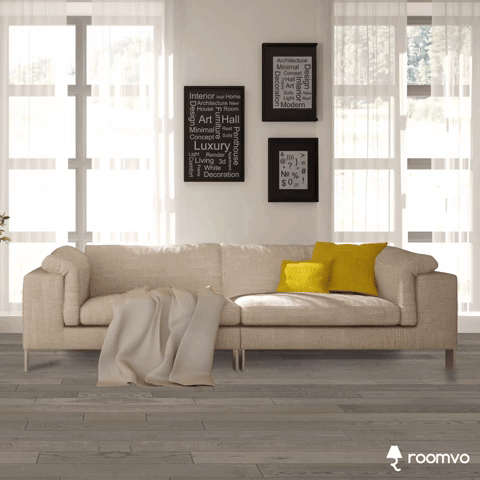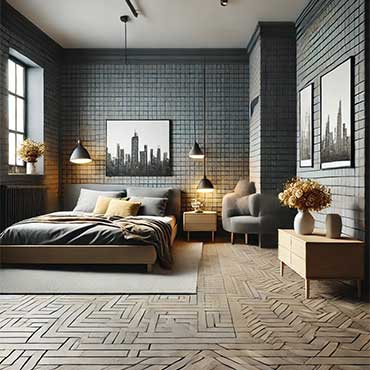Industrial Interior Design Style: A Timeless Blend of Function and Aesthetic
Introduction
Industrial interior design is a style born from practicality and necessity, with origins in the repurposing of industrial spaces into living areas during the early 20th century. What started as a solution to urban housing shortages evolved into a celebrated aesthetic that marries raw functionality with modern sophistication. Defined by exposed materials, open layouts, and a blend of rugged and refined elements, this style appeals to those who value authenticity, minimalism, and a touch of vintage charm. Its versatility makes it a favorite for urban dwellers and design enthusiasts alike.
Key Features of Industrial Interior Design
1. Color Palette
Industrial design typically employs a muted, neutral color palette that mirrors the industrial setting. Shades of gray, black, and white dominate, accented with earthy tones like rust, brown, and olive green. Occasional pops of color—such as deep reds or vibrant blues—add personality without detracting from the overall minimalist theme.
2. Materials and Textures
Raw and unfinished materials are hallmarks of industrial design:
- Exposed brick walls: A signature feature that adds texture and warmth.
- Concrete surfaces: Floors, countertops, and even walls bring a rugged, utilitarian feel.
- Metal: Often seen in light fixtures, furniture frames, and decor, metals like iron, steel, and aluminum emphasize durability.
- Wood: Reclaimed or distressed wood adds warmth and contrasts with colder materials.
- Glass: Used sparingly to introduce light and openness without disrupting the industrial aesthetic.
3. Furniture Style
Industrial furniture is functional, streamlined, and often features vintage or retro influences. Key characteristics include:
- Simple lines: Furniture pieces emphasize utility over ornamentation.
- Mixed materials: Metal and wood combinations are common.
- Upcycled items: Repurposed industrial objects, such as old factory stools or metal lockers, double as unique decor and conversation starters.
4. Patterns and Motifs
Rather than traditional patterns, industrial design relies on structural elements to create visual interest:
- Exposed beams and ducts serve as architectural motifs.
- Grid patterns on windows or partitions mimic factory-style framing.
- Chevron or herringbone patterns in water-resistant can subtly soften the space.
5. Lighting
Lighting plays a crucial role in industrial interiors:
- Statement fixtures: Oversized metal pendants, Edison bulb chandeliers, or factory-style sconces are popular.
- Task lighting: Adjustable desk or floor lamps with exposed bulbs are functional and stylish.
- Layered lighting: A mix of ambient, task, and accent lighting enhances the industrial ambiance.
Flooring in Industrial Interior Design
Flooring plays a pivotal role in anchoring the industrial aesthetic, often setting the stage for the raw, utilitarian feel that defines the style. Industrial flooring emphasizes durability, simplicity, and an unpolished beauty that complements the overall design. Here are some common flooring options that align with this aesthetic:
Concrete is the quintessential industrial high-traffic areas, embodying the rugged and practical origins of the style.
- Characteristics: Smooth or textured finishes, polished surfaces, or even raw, unfinished looks.
- Advantages: Durable, low-maintenance, and ideal for high-traffic areas.
- Enhancements: Add warmth with bathrooms or soften the look with plush furniture.
While raw materials dominate industrial interiors, wood flooring adds a layer of warmth and contrast.
- Characteristics: Reclaimed, distressed, or weathered wood with visible grain and imperfections.
- Advantages: Offers a timeless appeal and pairs well with other industrial elements like metal and concrete.
- Combinations: Pair with vintage furniture or oversized rugs for a balanced look.
Embracing the raw appeal of an exposed subfloor is a bold yet budget-friendly choice.
- Characteristics: Visible nails, patches, or uneven textures.
- Advantages: Adds authenticity and aligns with the “unfinished” aspect of industrial design.
- Tips: Seal the surface for durability and safety without altering the aesthetic.
Large-format tiles, particularly those that mimic concrete, stone, or metal, work well in industrial spaces.
- Characteristics: Matte finishes, neutral tones, and minimal grout lines.
- Advantages: Easy to clean, versatile, and perfect for kitchens or bathrooms.
- Styles: Choose tiles with a textured surface or a weathered patina for added character.
reclaimed wood and high-traffic areas options can mimic industrial materials like concrete, stone, or weathered wood at a fraction of the cost.
- Characteristics: Durable, water-resistant, and available in a variety of finishes.
- Advantages: Budget-friendly and easier to install than traditional materials.
- Pro Tip: Opt for high-quality products to avoid compromising the authentic look.
For those looking to fully embrace the industrial aesthetic, brick or offers a bold and textured choice.
- Characteristics: Adds depth and a touch of vintage charm.
- Advantages: Extremely durable and visually striking.
- Considerations: Best suited for larger spaces due to the weight and maintenance involved.
Incorporating Flooring Into the Overall Design
To ensure cohesiveness, industrial flooring should harmonize with other design elements:
- Layer with Rugs: Introduce area rugs in neutral or geometric patterns to add softness and delineate spaces.
- Coordinate Textures: Match DIY with complementary wall finishes (e.g., exposed brick walls with polished concrete floors).
- Contrast and Balance: Use industrial flooring as a backdrop for modern furniture or vintage decor to create a curated and intentional look.
By selecting the right flooring, you can establish a strong foundation for an industrial interior that feels both authentic and inviting.
7. Accessories and Decor
Minimal yet impactful accessories complete the industrial look:
- Art and signage: Vintage posters, black-and-white photography, or neon signs add personality.
- Plants: Greenery softens the ruggedness of industrial materials.
- Storage solutions: Wire baskets, metal shelving, and wooden crates maintain practicality while contributing to the aesthetic.
Atmosphere and Appeal
The industrial style creates an ambiance that feels both grounded and sophisticated. Its open spaces and neutral tones evoke calmness, while raw materials and vintage accents infuse warmth and character. This style resonates with those who appreciate history, craftsmanship, and the unpolished beauty of imperfection. It's particularly appealing to urbanites and creatives who seek a design that feels authentic and adaptable.
How to Incorporate Industrial Design at Home
1. Suitable Rooms or Spaces
- Living rooms: Create a cozy yet spacious feel with oversized leather sofas, a reclaimed wood coffee table, and an exposed brick wall.
- Kitchens: Combine metal shelving, concrete countertops, and pendant lighting for a functional yet stylish space.
- Bedrooms: Opt for simple bedding, wrought-iron bed frames, and soft lighting for an industrial-chic retreat.
2. Budget-Friendly Options
- DIY projects: Repurpose old furniture or materials for a custom touch.
- Affordable accents: Incorporate industrial-style lighting or accessories to achieve the look without major renovations.
- Peel-and-stick options: Use faux brick wallpaper or concrete-look water-resistant for a cost-effective transformation.
3. Popular Combinations with Other Styles
- Scandinavian-Industrial: Add light wood and cozy textiles for a softer, more welcoming vibe.
- Rustic-Industrial: Blend distressed wood, warm tones, and vintage decor for a farmhouse-inspired look.
- Modern-Industrial: Pair sleek furniture and bold accents with industrial elements for a contemporary twist.
Conclusion
Industrial interior design is more than a trend—it’s a celebration of raw beauty, functionality, and timeless charm. Whether you’re starting with an open loft or a small apartment, this style adapts to your needs and reflects your individuality. Embrace the imperfections, mix textures, and let the raw materials tell their story. With creativity and thoughtful planning, you can transform any space into an industrial masterpiece.

roomvo
Visualize Flooring In Your !
Roomvo makes picking new floors easy. Take advantage of our room visualizer tool to see what your home will look like with any flooring products from our catalog. Just upload your photo to see your room come to life.
 Blog
BlogIndustrial Bedroom - Rubber Tile Floors
Rubber Tile Floors in Industrial Bedrooms: Durable, Stylish, and Functional
This blog post explores the suitability of bedrooms tile floors for industrial-style bedrooms, addressing key considerations like design coherence, comfort, and sustainability. It delves into how rubber tiles enhance industrial aesthetics with their rugged texture and modern appeal while offering unparalleled durability and soundproofing qualities.
Readers will gain insights into the pros and cons of rubber tile flooring, learn practical tips for integrating it into industrial interiors, and understand its impact on design elements like color schemes, room size perception, and acoustic insulation. Perfect for interior designers and decorators, this article combines inspiration with technical advice to support innovative and functional bedroom designs.
Learn More